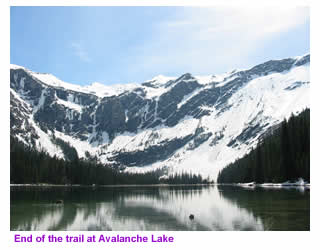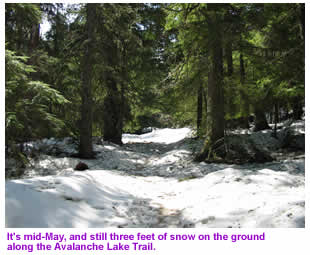Avalanche Lake
.gif)
Avalanche Lake is located in a cirque on the west side of the continental
divide. Massive mountains surround the lake, providing an unforgettable
scenic experience. The lake itself is named for the numerous avalanches
that roar down the surrounding mountains. For those of you lucky enough
to get to Avalanche Lake on a warm day soon after the trail opens in
May, you will be treated to the sights and sounds of many avalanches,
which is quite a sight if you have never seen one up close before. During
spring and early summer, these avalanches turn into dozens of waterfalls
that cascade down from the highest peaks.
Wildlife is abundant. Mountain goats are readily observed. Just look
for their white coats up against the brown and gray rocks. Other wildlife
includes bighorn sheep, deer, and of course, grizzly bears. Due to the
large number of people that use this trail and the trails passage through
mainly thick forest, bear sightings along this trail are rare.
Avalanche Lake is perhaps the most heavily used backcountry lake in
Glacier National Park. An easy hike up the two-mile long Avalanche Lake
Trail provides the only access to the lake. The trail itself is one of
the first trails to open in the park as well, as it's low elevation allows
the winter snows to melt off usually by early May.
The trailhead, which is located 6 miles up the Going-To-The-Sun Road
from the Lake McDonald Lodge, has decent parking and a campground. It
is impossible to miss when on the Sun Road. If you plan on hiking this
trail, do plan on arriving early. Even though there is lots of parking,
on busy days during the summer, parking can become scarce after noon.
The fishing on Avalanche Lake is not exactly exemplary. The cutthroat
trout that inhabit this very sterile lake tend to be quite small in size.
They are easy to catch on either a spin rod with small spoons or a small
dry fly. The outlet of the lake, which is where the trail ends, receives
a fair amount of fishing pressure by park standards. However, the lake
is easily walked around. A short hike up either side of the lake will
allow an angler to reach areas that are seldom fished. The water, as
it comes almost exclusively from snowmelt, is very cold, so plan on bringing
warm waders if you don't want to fish from shore. Another option is to
pack in a small raft or float tube. You may not find better fishing out
in the middle of the lake, but you will find views that few people ever
see.
Hiking Gear & Equipment Guide for Glacier National
Park |
 |
Hiking
Boots : Buyers guide to getting the
right boot for hiking |
Top of Page
|






.jpg)